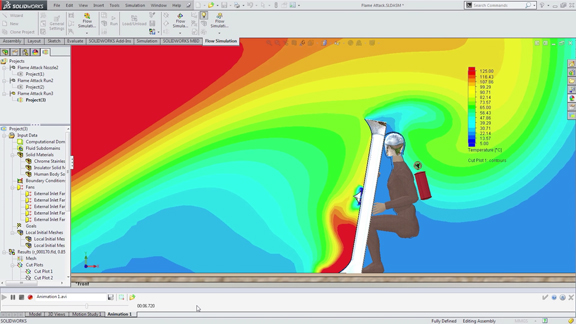
Latest News
April 29, 2016
 Using SolidWorks Simulation to figure out if a knight can survive a dragon’s attack by fire. (Image from SolidWorks YouTube video)
Using SolidWorks Simulation to figure out if a knight can survive a dragon’s attack by fire. (Image from SolidWorks YouTube video) The simulation shows that the knight doesn’t stand a chance in the standing pose, and his shield might need to be modified to offer better protection. (Image from SolidWorks YouTube video)
The simulation shows that the knight doesn’t stand a chance in the standing pose, and his shield might need to be modified to offer better protection. (Image from SolidWorks YouTube video) The simulation shows, with a modified shield that redirects the flames away from him, the knight in a crouching pose could possibly survive a dragon’s fiery breath. (Image from SolidWorks YouTube video)
The simulation shows, with a modified shield that redirects the flames away from him, the knight in a crouching pose could possibly survive a dragon’s fiery breath. (Image from SolidWorks YouTube video)Finite element analysis (FEA) and computational fluid dynamics (CFD) are serious stuff. Engineers use it to analyze car crashes, airplane cabins, and heart valves, among others. But if you’re a fantasy fiction and film buff, you might find other uses of the software. Stephen Endersby, a product manager at SolidWorks, decided to use SolidWorks Simulation to look into the strength and curvature of Katniss Everdeen’s bow, her weapon of choice in The Hunger Games.
After reviewing the displacement values and the stress fields, Endersby concluded he wouldn’t fare as well as the warrior girl from District 12. He noted, “By plotting the string/spring draw reaction over time, we can see that the maximum draw load is about 110N, for ¼ of a bow. Giving a total bow draw of 440N, or 99 lbf, this would indeed be a powerful bow, but one that I would not be able to draw to its full capacity.”
Last week, another mysterious video titled “SolidWorks Flow Simulation: A Song of CAD and CFD” emerged in SolidWorks YouTube channel. The clip’s creator is unknown, but his or her knowledge of dragon lore and CFD is impressive. It demonstrates how Johnny Snow, a fictional hero, might be able to survive a dragon’s fiery breath with a slight design change in his shield and adopting a crouching pose.
So DE reached out to SolidWorks PR with a few questions on the empirical data used to construct the simulation. Answers came from Mike Fearon, responsible for SolidWorks Brand Marketing.
Fearon explained, “We have a Chief Cultural Content Officer, who spends most of his time watching film and television. From what we understand, the idea [for the simulation of a dragon attack] materialized between viewings of Reign of Fire [the 2002 film set in a dragon-infested futuristic landscape, featuring Matthew McConaughey and Christian Bale] and the 1978 animated film Puff the Magic Dragon. Hearing Burgess Meredith voice a dragon and seeing Batman [the role Bale inhabited in several films] team up with Rust Cohle [McConaughey‘s role in the TV series True Detective] to fight dragons with helicopters will do strange things to your mind.”
In the simulation, the average length of a dragon’s attack by fire is set to 3 seconds, the basis for the external flow analysis. So where did this data come from? Fearon replied, “The research was taken from various pieces of footage demonstrating dragon fire in film and TV. Some of background information was taken from literature. However, we shouldn’t delve too greedily or deeply into the research, lest we should awake a Balrog [a mythical creature from Tolkien’s universe] residing in the dark corners of the internet where these details were gleaned.”
The simulation shows, with a slight modification of the shield’s edges, the valiant knight Sir Johnny Snow can redirect the incoming fire from the dragon’s nostril to disperse. He would also need to crouch behind the shield—a less heroic pose, unfortunately—during the attack. That would give him a fighting chance to save his skin during those three fatal seconds.
This may save the knight from a dragon spewing fire in a stationary position, but what about a flying dragon? To properly simulate this, the angle of attack must be traveling in a parabolic curve above the victim. Fearon said this, too, can be simulated in SolidWorks Simulation. “We’d likely use a series of transient analyses, but the Chief Cultural Content Officer cannot commit to any other projects at this time,” he explained.
If you happen to be a FEA or CFD wizard with an idle weekend, you might want to undertake the following simulation quests: What is the best materials to manufacture a fire-proof shield? (Perhaps a chance for composite analysis?) Are the odds in Sir Snow’s favor if he were armed with Katniss’s bow from The Hunger Games? (The challenge here is to find material data to simulate the toughness of the dragon skin and muscle; you won’t find that in the drop-down menu of the simulation program’s preloaded database.)
One nagging question, however, may be beyond the sorcery of even the most powerful FEA or CFD champions: How would one transport a copy of SolidWorks Simulation to a knight who lives in the Middle Ages?
Subscribe to our FREE magazine, FREE email newsletters or both!
Latest News
About the Author
Kenneth Wong is Digital Engineering’s resident blogger and senior editor. Email him at [email protected] or share your thoughts on this article at digitaleng.news/facebook.
Follow DE





